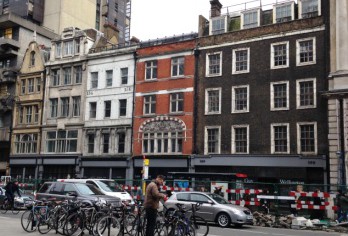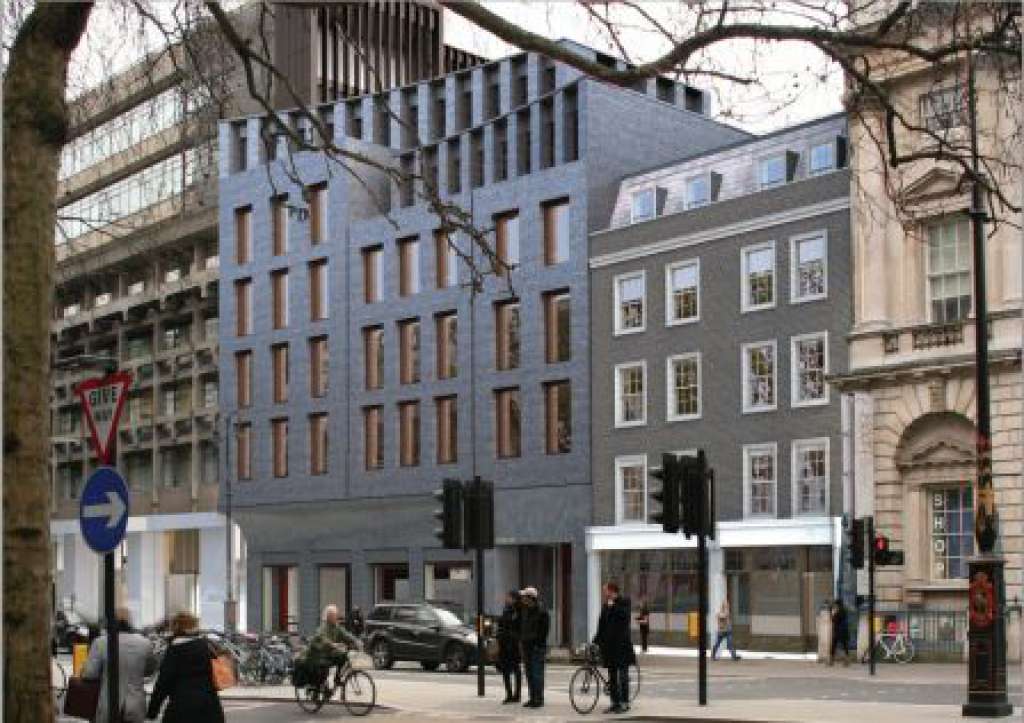Press Release and Call To Arms: Stay Of Execution For Strand Buildings
15 May 2015
Press Release And Call To Arms: Stay Of Execution For Strand Buildings - SAVE Keeps The Pressure Up
Last night (Thursday 13th) Secretary of State for communities and local government, Greg Clark MP, issued Westminster Council with a holding direction, that suspends planning permission for Kings College's plans while ministers consider whether to call in the application for public inquiry.
SAVE welcomes this decision that follows our request to him on May 11th. We originally wrote to Eric Pickles MP, then Secretary of State for Communities and Local Government on 23rd April, asking him to call in the application for public inquiry. We repeated our request to his successor, Greg Clark MP, highlighting the storm of public outrage and national press attention that has developed since our original letter, as well as the changing stance of Historic England. Our full letter is attached.
In our letter we explain why the application should be called in for public inquiry. We write:
"Most pointedly, there is a conflict with national policy on the protection of heritage assets. These buildings make up the background of listed buildings in a historically important part of London, visited by many thousands of visitors on a daily basis. As part of one of London's most historic thoroughfares, the buildings are of national significance. The conclusions drawn by Historic England could have negative repercussions on a national scale if not challenged. In addition the proposed new design for the replacement building is of extremely low quality."
Our request for a public inquiry has been supported and endorsed by a group of Westminster Councillors, who have also written to Greg Clark. Councillor David Boothroyd, the only member to vote against the proposals said:
"The new Secretary of State should call-in this proposal given the significant change in Historic England's comments and the huge national interest. The current proposals would not only mean a loss of this lovely terrace of historic buildings, but would be a repeat of the mistakes made in the 1970s when King's College was allowed to build a Brutalist development which was totally unsympathetic with The Strand and nearby Somerset House."
We have also written to those who have signed our petition, that has gathered almost 8,500 signatures in just over two weeks, asking them to write to Greg Clark MP, requesting that this application be called in for a public inquiry.
Please write to Greg Clark, Secretary of State, requesting these applications be called in for public inquiry.
Letters should be emailed to greg.clark@communities.gsi.gov.uk and copied to npcu@communities.gsi.gov.uk, or posted to the Department of Communities and Local Government, Eland House, Bressenden Place, London, SW1E 5DU
SAVE's grounds for requesting a public inquiry:
The proposals are in direct conflict with national planning policy guidance on heritage protection. It proposes the demolition of four 'unlisted buildings of merit' in a Conservation Area and the façading of a Grade II listed building. These buildings are protected in local policy (Policy DES 9 on Conservation Areas) and in law, which defines conservation areas as 'areas of special architectural or historic interest, the character or appearance of which it is desirable to preserve or enhance.' The demolition would damage the setting of two Grade I listed buildings - Somerset House and St Mary Le Strand.
As part of one of London's most historic thoroughfares, the buildings are of national significance.
The proposed new building is of a bland design, which fails to respond its surroundings. It does not preserve or enhance the special character of the conservation area.
The proposals and the consultation have created controversy, that need to be fully explored in a public inquiry. Firstly, Historic England's advice letter to Westminster Council is flawed, as it fails to apply the appropriate tests for development in a Conservation Area. Their statement of the 13 May 2015 further confuses their stance on this application. Rather than simply advise the local authority to take this into consideration when determining the application, they had taken it on themselves to conclude that the benefits outweigh the harm.
SAVE challenges this strongly, and challenges whether Historic England has the expertise to weigh up some of these benefits. Tim Jones, Principal Inspector of Historic Buildings and Areas for Historic England, wrote in his original letter to Westminster Council regarding the scheme on 23rd March 2015:
"Whilst the loss of the unlisted buildings is regrettable their demolition... does not strike at the heart of the significance of the Conservation Area, why it was designated. Their loss would therefore be considered 'less than substantial harm' and when weighted against the public benefits. I consider that these benefits outweigh the harm." (See full letter attached).
There were strong objections to the planning application from the Courtauld Institute, Somerset House, and over 60 others including several national amenity societies. Their objections also flag up what they see as major flaws in the consultation process.
There has been overwhelming strong public outrage expressed towards these proposals, and this has resulted in major press coverage from many different local and national news outlets, reflecting the national importance of the case.
SAVE considers that it is not been proven that the public benefits as presented by the applicant depend on the demolition of these buildings. SAVE considers that a sensitive retention and restoration scheme can address the university's concerns about these buildings.
SAVE Director Clem Cecil says: "This has been the most popular petition we have ever held for a historic building or group of buildings and we have been inundated by enquiries and expressions of concern. These are quintessentially London buildings that people identify with and feel strongly about. This is a stretch of the Strand that desperately needs improving. We are saying that this is possible through the sensitive treatment of this group of characterful historic buildings, that are an asset to the university, and not through demolition."
Background
152 - 158 Strand are buildings of great charm on one of London's most historic and central thoroughfares: the procession route from St Paul's Cathedral to Buckingham Palace. The existing buildings also provide the setting for the Grade I listed Somerset House and St Mary Le Strand.
They were originally part of a late-seventeenth/early-eighteenth century terrace, and are sited on their original narrow medieval burgage plots. The building frontages have been partially or fully re-fronted during the mid-nineteenth and early-twentieth century, but the majority of interior and rear walls relate to the eighteenth century.
The Strand has been the principal route between the economic centre of the City of London and the royal and political centre of Westminster for centuries. As these centres grew in the sixteenth and seventeenth centuries, the Strand became a commercial strip and significant landmark buildings and churches were established. By the end of the nineteenth century, the Strand was renowned as an area for restaurants, public houses, music halls and theatres. As a result, the Strand has developed a variety of building and architectural styles, with its grand landmark buildings on the one hand, and an assortment of commercial building on narrow medieval plots on the other.
The buildings at 152-158 Strand are tangible memories of the commercial businesses and occupiers of the buildings that were on the Strand for over 200 years. A variety of businesses occupied the buildings, including tailors, locksmiths, watch-makers, button-makers, umbrella-makers, architects, booksellers, tobacconists, photographers, shoe-sellers, confectioners, lamp manufacturers, estate agents and dentists. This variety and number are typical of these kinds of buildings on the Strand.
Although there was a high turnover of owners and leases of the buildings, some notable businesses occupied the buildings for decades - including Firman & Sons (military button-makers founded in 1656, one of the top 25 oldest companies in the world), Thresher & Glenny (founded in 1755 and one of the world's oldest surviving tailors), George & Walter Yonge (watchmakers, notable as being watchmakers for the King and the Lord High Admiral 1820-28), and Lyons café (a successful teashop chain, particularly in the 1930s).
The buildings at 152-158 not only typify the physical and historical character of the Strand Conservation Area, but also have significance for their association with the Grade I listed Somerset House and St Mary-le-Strand. The row of buildings, which is mirrored on the southwest side of Somerset House by a similar row, provides an authentic sense of how Somerset House and St Mary le Strand church fitted into an eighteenth century streetscape. Historical paintings and photographs of these features include the buildings at 152-158 Strand, illustrating the importance of these buildings to the eighteenth and nineteenth century context of the Strand.
The entire group of threatened buildings are in the Strand Conservation Area, while one of them is listed Grade II. The ones condemned for demolition are singled out in the Conservation Area Audit as Unlisted Buildings of Merit, which contribute to the character and appearance of the Conservation Area. This should, according to local planning policy, safeguard them from this kind of proposal.
King's College received planning permission to demolish 154-158 and façade 152-153 the Strand at a Westminster planning committee meeting on the 21st April. SAVE submitted strong objections to the planning application, along with the Victorian Society, The Ancient Monument Society, LAMAS, the Courtauld Institute and the Somerset House Trust, as well as many individuals, but these objections were ignored.
Historic England acknowledged that the proposals would cause harm to the conservation area, but that this harm would not be substantial when considering the public benefits of the scheme. We strongly disagree and consider the demolition unjustified and unacceptable. One of Historic England's central justifications is erroneous since it hinges on the fact that these buildings have been internally altered. However, conservation areas are not designated primarily for their interiors and works to interiors do not require permission. SAVE considers that the public benefits of the King's College scheme can be substantially delivered without demolishing these buildings. Equally it is vital to remember that this cityscape is shared with all Londoners and visitors to the city.
This streetscape has already been damaged by King's College's Brutalist building to the east of Somerset House. No further encroachment of this kind should be allowed. The character of central London depends on a balance between large institutional and commercial buildings and smaller scale buildings on narrow plots.
The proposed design does not respect Westminster's heritage and local distinctiveness - it replaces a group of buildings with distinctive façades with something terrifically bland.
For more information and images, please contact the SAVE Office on 0207 253 3500 or office@savebritainsheritage.org, or Clem Cecil on 07968 003 595
Press Coverage
Over the past two weeks there has been considerable press coverage of this case. Below is a sample:
The Times:
http://www.thetimes.co.uk/tto/arts/visualarts/architecture/article4434996.ece
http://www.thetimes.co.uk/tto/opinion/leaders/article4435366.ece
http://www.thetimes.co.uk/tto/arts/visualarts/architecture/article4440728.ece
The Evening Standard:
The BBC:
http://www.bbc.co.uk/news/uk-england-london-32681126
http://www.bbc.co.uk/news/uk-england-london-32752706
London Live:
The Daily Mail:
The Architectural Journal:
Building Design:
http://www.bdonline.co.uk/news/save-urges-clark-to-call-in-hall-mcknight-scheme/5075368.article
Time Out, London:
The Financial Times:
http://www.ft.com/cms/s/0/cf076fa2-fa68-11e4-a41c-00144feab7de.html#axzz3aD1gvdsV
Notes to editors:
SAVE Britain's Heritage has been campaigning for historic buildings since its formation in 1975 by a group of architects, journalists and planners. It is a strong, independent voice in conservation, free to respond rapidly to emergencies and to speak out loud for the historic built environment.
SAVE Britain's Heritage, 70 Cowcross Street, London EC1M 6EJ
Registered Charity 269129
Tel. 020 7253 3500 Email office@savebritainsheritage.org
www.savebritainsheritage.org
Follow SAVE on Twitter: @SAVEBrit


